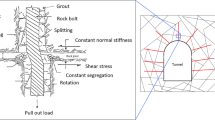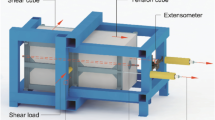Abstract
Rock bolt is a support system extensively utilized in Civil and Mining Engineering applications, especially for underground excavations projects. The main function of a rock bolt is to stabilize the rock mass around the opening of an excavation by fastening to further stable formations. Previous technical work developed pull-out testing in order to improve understanding regarding the mechanical response within this system. However, due to limitations with conventional laboratory methods of capturing strain, there still exists a lack of understanding in this mechanical response at the micro-scale; more specifically, in the detailed strain profile distribution along fully grouted rock bolts. Aiming to address this knowledge gap, two research programmes were conducted and will be addressed in this paper: numerical modelling of pull-out tests through finite element method (FEM) and hybrid finite-discrete element method (FDEM), and laboratory pull-out tests on concrete samples utilizing a newly developed distributed optical strain sensing technology that provides a spatial resolution of 0.65 mm in order to capture the strain along the rock bolt. Experimental and modelling results were compared to evaluate the numerical approaches feasibility and their correspondence with the experiments. FDEM modelling demonstrated ability in capturing general mechanical behavior, while the FEM software seems to be a good option to be utilized as a design tool, yet improvements to the interaction model are necessary to achieve a better calibration with experimental results.














Similar content being viewed by others
References
Ardiaca DH (2009) Mohr–Coulomb parameters for modelling of concrete structures. Plaxis Bull 25:12–15
Azziz N, Webb B (2003) Study of load transfer capacity of bolts using short encapsulation push tests. In: Coal operators’ conference, pp 72–80
Barton N (2012) Defining NMT as part of the NATM SCL debate. https://www.researchgate.net/publication/321938040_Barton_N_2012_Defining_NMT_as_part_of_the_NATM_SCL_debate_TunnelTalk
Benmokrane B, Chennouf A, Mitri HS (1995) Laboratory evaluation of cement-based grouts and grouted rock anchors. Int J Rock Mech Min Sci 32(7):633–642
Cruz DF (2017) The geomechanical response of axially loaded fully grouted rock bolts utilizing fibre optics technology. Master of science thesis, Royal Military College of Canada, Kingston
Forbes B, Vlachopoulos N, Oke J, Hyett AJ (2014) The application of distributed optical sensing for monitoring temporary support schemes. GeoRegina, Canadian Geotechnical Society, Regina
Forbes B, Vlachopoulos N, Hyett AJ (2018) The application of distributed optical strain sensing to measure the strain distribution of ground support members. FACETS 3(1):195–226
Haas CJ (1975) Shear resistance of rock bolts. In: 104th annual meeting of American Institute of Mining, Metallurgical and Petroleum Engineers, pp 32–40
Hyett AJ, Forbes B, Spearing S (2013) Enlightening bolts: using distributed optical sensing to measure the strain profile along fully grouted rock bolts. In: Proceedings of the 32nd international conference on ground control in mining, Morgantown, VW, pp 107–112
Mahabadi OK, Lisjak A, Munjiza A, Grasselli G (2012) Y-Geo: new combined finite-discrete element numerical code for geomechanical applications. Int J Geomech 12(6):676–688. https://doi.org/10.1061/(asce)gm.1943-5622.0000216
Mark C, Compton CS, Oyler DC, Dolinar DR (2002) Anchorage pull testing for fully grouted roof bolts. In: Proceedings of the 21st international conference on ground control in mining. West Virginia University, Morgantown, pp 105–113
Martín LB, Tijani M, Hadj-Hassen F, Noiret A (2013) Assessment of the bolt-grout interface behaviour of fully grouted rockbolts from laboratory experiments under axial loads. Int J Rock Mech Min Sci 63:50–61
Moosavi M, Bawden WF, Hyett AJ (2002) Mechanism of bond failure and load distribution along fully grouted cable-bolts. Min Technol 111(1):1–12
Moosavi M, Jafari A, Khosravi A (2005) Bond of cement reinforcing bars under constant radial pressure. cement and concrete composites. Elsevier, Amsterdam, pp 103–109
Munjiza A (2004) The combined finite-discrete element method. Wiley, Hoboken
RocScience (n.d.) Bolt formulation. In: Phase 2 theory. Retrieved from RocScience website. https://www.rocscience.com/help/rs2/phase2_model/Bolts_Overview.htm. Accessed 2019
Signer SP (1990) Field verification of load transfer mechanics of fully grouted roof bolts. Bureau of Mines, Pittsburg
Stillborg B (1986) Professional users handbook for rock bolting. Trans Tech Publications, Aedermannsdorf
Tatone BSA, Lisjak A, Mahabadi OK, Vlachopoulos N (2015) Incorporating rock-reinforcement elements into numerical analyses based on the hybrid combined finite-discrete element method (FDEM). International Society of Rock Mechanics, Montreal
Vlachopoulos N, Cruz D, Forbes B (2018) Utilizing a novel fiber optic technology to capture the axial response of fully grouted rock bolts. J Rock Mech Geotech Eng 10(2):222–235
Yazici S, Kaiser PK (1992) Bond strength of grouted cable bolts. Int J Rock Mech Min Sci Geomech Abstr 29(3):279–292. https://doi.org/10.1016/0148-9062(92)93661-3
Zivaljic N, Smoljanovic H, Nikolic Z (2013) A combined finite-discrete element model for RC structures under dynamic loading. Eng Comput Int J Comput Aided Eng 30(7):982–1010. https://doi.org/10.1108/EC-03-2012-0066
Acknowledgements
The authors would like to thank the Natural Sciences and Engineering Council of Canada (NSERC), the Canadian Department of National Defence, Yield Point Inc., Geomechanica Inc. and The Royal Military College (RMC) Green Team.
Author information
Authors and Affiliations
Corresponding author
Additional information
Publisher's Note
Springer Nature remains neutral with regard to jurisdictional claims in published maps and institutional affiliations.
Rights and permissions
About this article
Cite this article
Vlachopoulos, N., Cruz, D., Tatone, B.S.A. et al. The Performance of Axially Loaded, Fully Grouted Rock Bolts Based on Pull-Out Experiments Utilizing Fiber Optics Technology and Associated Numerical Modelling of Such Support Elements. Geotech Geol Eng 38, 1389–1407 (2020). https://doi.org/10.1007/s10706-019-01098-3
Received:
Accepted:
Published:
Issue Date:
DOI: https://doi.org/10.1007/s10706-019-01098-3




